
Fatih, historically Constantinople, is the capital district of and a municipality (belediye) in Istanbul, Turkey, which hosts all the provincial authorities, including the governor's office, police headquarters, metropolitan municipality and tax office, but not the courthouse; while encompassing the peninsula coinciding with old Constantinople. In 2009, the district of Eminönü, which had been a separate municipality located at the tip of the peninsula, was once again remerged into Fatih because of its small population. Fatih is bordered by the Golden Horn to the north and the Sea of Marmara to the south, while the Western border is demarked by the Theodosian wall and the east by the Bosphorus Strait.
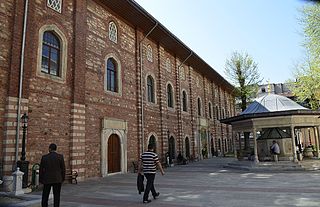
Arap Mosque is a mosque in the Karaköy quarter of Istanbul, Turkey. The building was originally a Roman Catholic church erected in 1325 by the friars of the Dominican Order, near or above an earlier chapel dedicated to Saint Paul in 1233. Although the structure was altered during the Ottoman period, it is the only example of medieval religious Gothic Architecture remaining in Istanbul.

The Bayezid II Mosque is an early 16th century Ottoman imperial mosque located in the Beyazıt Square area of Istanbul, Turkey, near the ruins of the Forum of Theodosius of ancient Constantinople.

The Kariye Mosque, or the Church of the Holy Saviour in Chora, is a medieval Greek Orthodox church used as a mosque today in the Edirnekapı neighborhood of Istanbul, Turkey. The neighborhood is situated in the western part of the municipality (belediye) of the Fatih district. The Church of the Holy Saviour in Chora was built in the style of Byzantine architecture. In the 16th century, during the Ottoman era, the Christian church was converted into a mosque; it became a museum in 1945, but was turned back into a mosque in 2020 The interior of the building is covered with some of the oldest and finest surviving Byzantine Christian mosaics and frescoes; they were uncovered and restored after the building was secularized and turned into a museum.
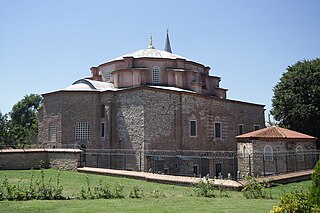
Little Hagia Sophia Mosque, formerly the Church of Saints Sergius and Bacchus, is a former Greek Eastern Orthodox church dedicated to Saints Sergius and Bacchus in Constantinople, built between 532 and 536, and converted into a mosque during the Ottoman Empire.
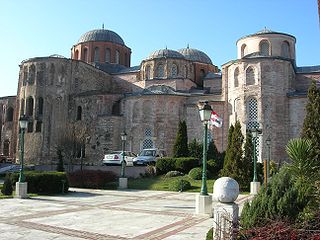
Zeyrek Mosque or Monastery of the Pantocrator, is a significant mosque in Istanbul, made of two former Eastern Orthodox churches and a chapel. It represents the most typical example of architecture of the Byzantine middle period in Constantinople and is, after Hagia Sophia, the second largest religious edifice built by the Byzantines still standing in Istanbul.

Fenâri Îsâ Mosque, in Byzantine times known as the Lips Monastery, is a mosque in Istanbul, made of two former Eastern Orthodox churches.

Pammakaristos Church, also known as the Church of Theotokos Pammakaristos, is one of the most famous Greek Orthodox Byzantine churches in Istanbul, Turkey. Adapted in 1591 into the Fethiye Mosque, it is today partly a museum, the parekklesion. The edifice serves as one of the most important examples of Constantinople's Palaiologan architecture, and the last pre-Ottoman building to house the Ecumenical Patriarchate. It also has the largest amount of Byzantine mosaics in Istanbul after the Hagia Sophia and Chora Church.

The Hagia Sophia in Thessaloniki, Greece, is one of the oldest churches in the city still standing today. It is one of several monuments in Thessaloniki included as a World Heritage Site on the UNESCO list.

Gül Mosque is a former Eastern Orthodox church in Istanbul, Turkey, converted into a mosque by the Ottomans.
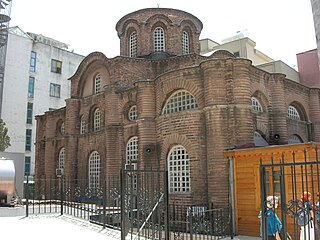
Bodrum Mosque in Istanbul, Turkey, is a former Eastern Orthodox church converted into a mosque by the Ottomans. The church was known under the Greek name of Myrelaion.
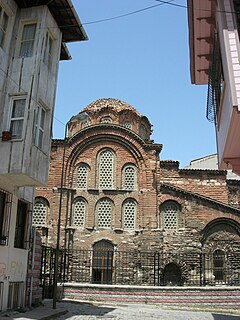
Eski Imaret Mosque is a former Eastern Orthodox church converted into a mosque by the Ottomans. The church has traditionally been identified with that belonging to the Monastery of Christ Pantepoptes, meaning "Christ the all-seeing". It is the only documented 11th-century church in Istanbul which survives intact, and represents a key monument of middle Byzantine architecture. Despite that, the building remains one among the least studied of the city.

Church-Mosque of Vefa is a former Eastern Orthodox church converted into a mosque by the Ottomans in Istanbul. The church was possibly dedicated to Hagios Theodoros, but this dedication is far from certain. The complex represents one of the most important examples of Comnenian and Palaiologan architecture of Constantinople.

Hirami Ahmet Pasha Mosque is a former Eastern Orthodox church converted into a mosque by the Ottomans. The small church, one among the 36 dedicated to Saint John the Baptist in Constantinople, was part of a monastery bearing the same name. Its full name was Saint John the Forerunner by-the-Dome. It is the smallest Byzantine church of Constantinople still extant and has never been studied.

Koca Mustafa Pasha Mosque is a former Eastern Orthodox church converted into a mosque by the Ottomans, located in Istanbul, Turkey. The church, as the adjoining monastery, was dedicated to Saint Andrew of Crete, and was named Saint Andrew in Krisei or by-the-Judgment. Although heavily transformed during both the Byzantine and the Ottoman eras, it is one among the few churches in Istanbul still extant, whose foundation goes back to the sixth century.

Atik Mustafa Pasha Mosque is a former Eastern Orthodox church in Istanbul, converted into a mosque by the Ottomans. The dedication of the church is obscure. For a long time it has been identified with the church of Saints Peter and Mark, but without any proof. Now it seems more probable that the church is to be identified with Saint Thekla of the Palace of Blachernae. The building belongs stylistically to the eleventh-twelfth century.
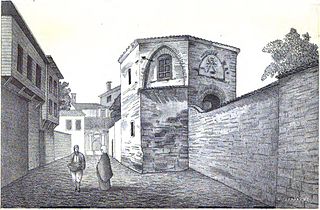
Şeyh Süleyman Mosque is a mosque in Istanbul converted from a former Byzantine building which was part of the Eastern Orthodox Pantokrator Monastery. Its usage during the Byzantine era is unclear. The small building is a minor example of architecture of the Byzantine middle period in Constantinople.
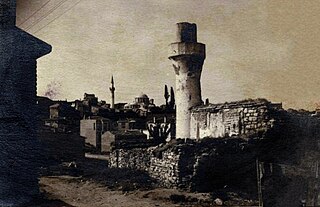
The Odalar Mosque was an Ottoman mosque in Istanbul. The building was originally a Byzantine-era Eastern Orthodox church of unknown dedication. In 1475, after the Fall of Constantinople (1453), it became a Roman Catholic church, dedicated to Saint Mary of Constantinople, until finally it was converted into a mosque by the Ottomans in 1640. The mosque was destroyed by fire in 1919, and since then has fallen into ruin. As of 2011, only some walls remain, hidden among modern buildings.

Toklu Dede Mosque, was an Ottoman mosque in Istanbul, Turkey. The building was originally a Byzantine Eastern Orthodox church of unknown dedication. It was almost completely destroyed in 1929.
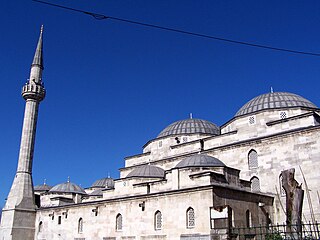
The Mahmut Pasha Mosque is a 15th-century Ottoman mosque close to the Grand Bazaar in the Eminönü district of Istanbul, Turkey.




![Interior of Kalenderhane Mosque from 1903. Diaconissa, Istanbul, Turkey, 1914. [Survey 1914. Istanbul; Diaconissa]; Sebah & Joaillier. Phot. Brooklyn Museum Archives, Goodyear Archival Collection S03 06 01 009 image 1165.jpg](http://upload.wikimedia.org/wikipedia/commons/thumb/0/09/S03_06_01_009_image_1165.jpg/330px-S03_06_01_009_image_1165.jpg)






























